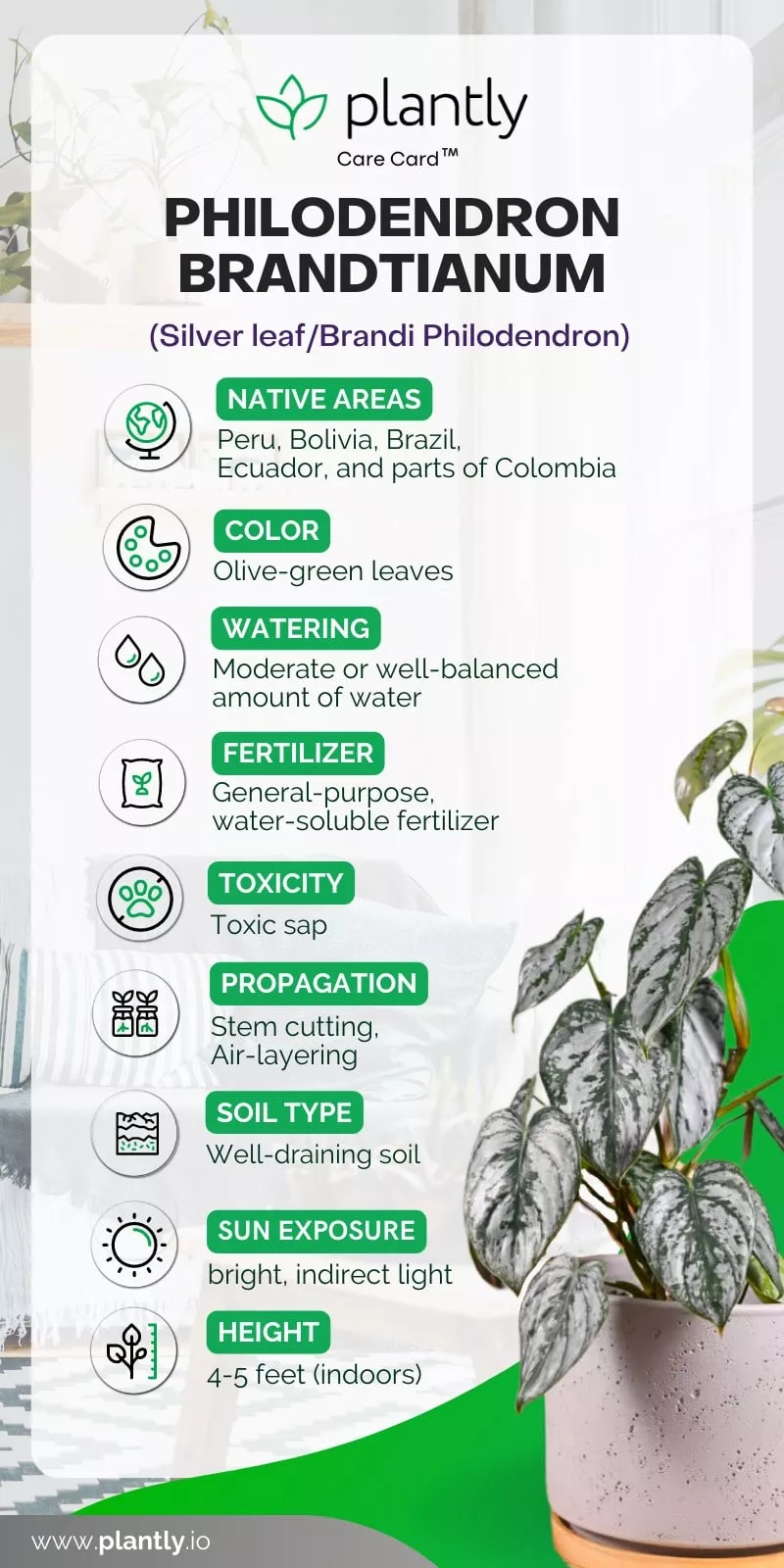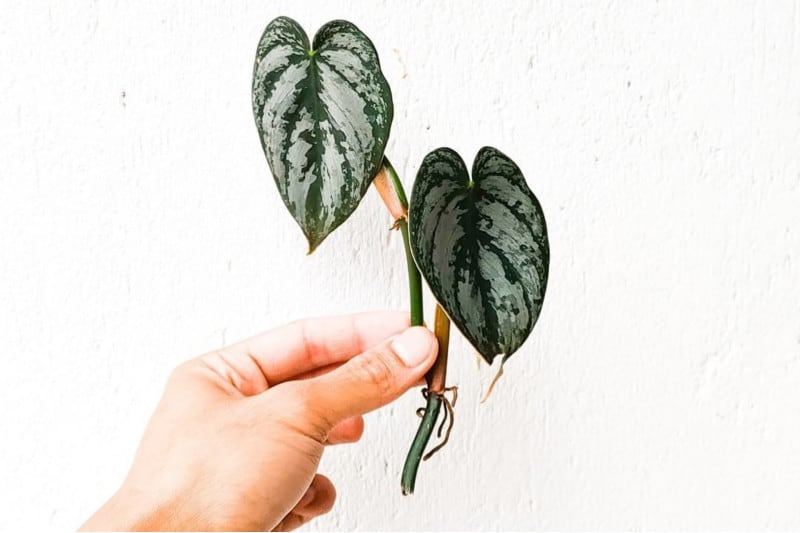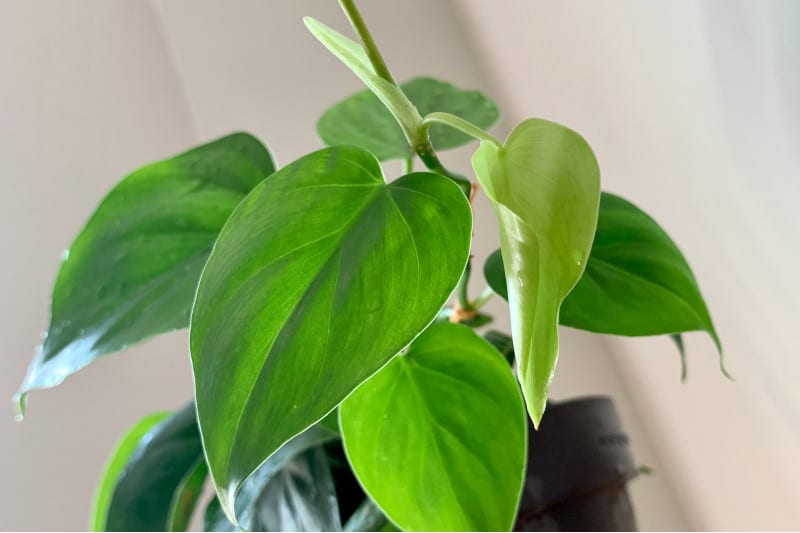No products in the cart.
Table of Contents
A “climber” elongated heart-shaped leaf plant, this is Philodendron brandtianum. An epiphyte plant of the Araceae family requires minimal maintenance and is easy to grow, whether indoors or outdoors.
Philodendron brandtianum makes an excellent view for hanging baskets or terrains and has attractive olive green with silver or white patches on its leaves. Philodendron Brandi, or Silver Leaf, is an excellent plant to grow for beginners.
Plants such as Philodendrons are known to be “easiest to grow, hardest to die,” so they do, evolving, not need the expertise to keep them alive.
And with this, here are some helpful care tips on how to take care of your new best plant friend!
Philodendron Brandtianum Plant Care Basics

Philodendron brandtianum is one of the easiest plants to care for, making it an excellent choice for newbies to the Philodendron family. This plant will not only beautify your home’s interior but will also act as an air filter by removing toxins from the air.
Before we move on to the essential care tips for this plant, here’s a table of information that you need to know about Philodendron brandtianum.

So are you ready for a more extensive discussion of care and maintenance tips for silver leaf philodendron? Keep reading, then.
Recommended Potting Mix
Philodendron brandtianum should be grown in a rich, well-drained potting mix at all times. Drainage holes on the bottom of the container or pot are required. Before planting, amend the soil with fertilizer or well-composted manure.
During the growing season, keep the potting soil moist at all times. Wet, clumpy, arid, or sandy soils are avoided when planting this gorgeous green. This Philodendron thrives in soil that is porous, well-drained, and rich in organic matter.
It can also be grown in 100% sphagnum peat moss. For this plant, soil-based mixes like peat-vermiculite or peat-perlite work well.

Watering Needs
For the water requirement, you should also provide your indoor plant with the best condition. During summer, you can water it three times per week. During cold days, though, you can cut back on watering to once a week.
The plant is vulnerable to overwatering because it is an epiphytic plant with aerial roots. The Philodendron brandtianum plant should not sit in water for an extended period. Avoid watering the leaves because the bacteria will develop and spread if the moisture sits on the leaves.
Lighting
Philodendron brandtianum requires bright indirect sunlight. This plant thrives in a wide range of light conditions but thrives best in medium or filtered daylight. If you want to grow it outside, cover it with a 20-40% shade cloth.
Partially shaded outdoor settings are also adequate, keeping the plant out of direct sunlight during peak hours to avoid damaging the foliage. As long as the light is indirect, this plant can readily endure low to high lighting.
Put your plant in bright natural daylight if you want it to develop faster and healthier.
Temperature
Grow the Philodendron Brandtianum plant somewhere warm, between 10-35 degrees Celsius (50-95 degrees Fahrenheit). You can move the plant outside throughout the summer, but it must be brought inside before the first frost.
During the winter, relocate the plant to a warmer spot.
Avoid keeping your plant near air conditioning units, radiators, or vents to prevent any harsh or drying circumstances. This species is not highly winter resistant, especially in colder climates.
Generally, the ideal temperature during the day is between 20-25 degrees Celsius (68-77 degrees F), while the average temperature during nighttime should be above 12 degrees Celsius (55 degrees F).
Humidity
Above-average humidity is ideal for the Philodendron brandtianum. The plant’s development will be accelerated, and its foliage will be more significant. The humidity level in the house should be regulated between 50 and 60% because if the air is dry, spray the leaves or use a pebble tray to provide humidity.
To preserve the plant from fungus or leaf rot, mist it occasionally but always provide proper aeration.

Fertilizer
Be sure to use a high-quality fertilizer while nourishing your Philodendron brandtianum. Using a substandard fertilizer containing heavy salts can cause significant damage to plants, just as it can to any other plant. Because Philodendron brandtianum is a slow-growing plant, it benefits from a slow-release 15-5-10 fertilizer in the spring and summer.
You can aid the growth of your plant by feeding it general-purpose, water-soluble houseplant fertilizers. You can give the mature plant a houseplant fertilizer once a month during the growing period, which is spring and summer. In the winter, the plant won’t require much fertilizer.
Propagation

Philodendron is also popular because of the convenience of easy propagation, and this means you may quickly expand your collection of this lovely plant at home. Stem cuttings are usually the way to propagate the Silver-Leaf Philodendron.
Propagation is best done in the spring or early summer. It’s best to do it earlier in the season to give your new plant more time to establish itself.
Growth Zone
Philodendron brandtianum is a climbing philodendron with a rapid growth rate. In around 2-3 years, it reaches its full height. Placing a totem in the soil can help it grow faster since it supports and climbs. It’s also worth noting that the environment and evolving circumstances affect plant height and leaf size.
Indoor vines typically reach a height of 4 to 5 feet when fully grown. They can grow to be much taller if treated as an outdoor plant. An average leaf measures 4 to 7 inches in length, but a mature leaf can measure up to 12 inches in length.
Potting
It would be best if you choose the pot that best suits your needs. The best recommendation is to use hanging baskets, terrariums, terrestrial pots, or any containers with drainage holes at the bottom. The plants will most likely thrive when you use those kinds of pools.
It would help if you also remember that the looser your Philodendron brandtianum roots are, the higher and healthier your plant will be. You can transplant your plant every two to three years, but if you observe anything unusual, such as your plant going overcrowded in its pot, you can re-pot it to a larger container.
Pruning
While hanging or climbing, the Philodendron brandtianum plant has a tight growth pattern and develops leaves near each other. The plant can be pruned once or twice a year. Remove any dead or broken leaves from the lower section of the plant to keep it looking nice and help it flourish.
Philodendron brandtianum Varieties and Similar Plants
The beauty of this plant could add to the fragment of your collection. Below are some beautiful philodendron varieties you can add to your brandy.
Philodendron hastatum

The Philodendron hastatum is a scarce plant known as the Silver Sword Philodendron because of its metallic-like foliage. When it grows, the shape of the leaves looks like an arrow. The plant also loves to climb, so it is best to place it on a post or plant support.
To care for this plant, it should be in an area where it has indirect sunlight. The humidity is average reporting and a well-draining potting mix.
Philodendron hederaceum

It is known as the evergreen climber that goes up to around 3-6 meters. This plant has heart-shaped leaves similar to the brandtianum which goes about 12 inches.
A way to take care of the Philodendron hederaceum must be watered at least every 5-7 days, the soil must be an all-purpose potting mix, and the ground must be kept moist.
Philodendron brandtianum Diseases & Pests
The Philodendron brandtianum plant has a lot of common issues despite being reasonably easy to take care of since it’s just low maintenance. Still, when it’s not entirely taken care of, some cases could happen to it. Here are some of them:
Diseases
Fungi and bacteria are some of the causes of the diseases of the plant. There’s also a case where the plant starts to have root rot and Rhizoctonia, which turns the leaves yellow, brown, and floppy.
A way to treat this is to place it in an area where it has indirect sunlight when the plant is still in a growing process.
Make sure that the top inch of the soil is dry before watering again, and it’s best to know this by placing your finger on the ground. When the plant is rotting, use a pair of shears or scissors, making sure it’s sharp to cut off the affected roots to prevent them from evolving from spreading.
Pest
Pests usually happen when the plant has received too much or inadequate water, sunlight, and humidity. To get rid of such problems, you must ensure that chose the plant is healthy and that the ground can be well-drained. Give enough light and water. Despite the plant’s low maintenance, it still needs those from time to time.
Also, do pest management from time to time by using low-toxic insecticidal sprays like soaps, neem, or pyrethrins to get rid of bugs such as aphids, mealybugs, spider mites, and scales.
Frequently Asked Questions
There could be many reasons as to why the leaves of the plant turn yellow. One of the reasons is if you place it near a window where there’s direct sunlight, this can cause sunburn to the leaves, turning it yellow. 2nd if there are too many yellowing leaves, it is too dry, and a resuscitation procedure can be done to give the plant a fresh start.
There are fewer chances of the leaves going back to green, especially when it’s not properly cared for. There’s still a chance, but it’s best not to get your hopes up, but it doesn’t mean the plant is already dying. There are some cases where the yellowing is a warning that there is something wrong with it. Once the plant is treated immediately, then the P. brantianum plant can go back to its former glory.
Philodendron brandtianum is a rare plant because of its olive-green leaves with a striking gray mottling and silver marking. It can get large when attached to support growing upwards, but the leaves will remain small if it’s on the trail. The plant’s heart-shaped leaves can also be placed on the basket, ensuring that it is direct sunlight only for a partial amount of time and letting it dry out every time after watering.
Luckily you don’t need to go around looking for the beauty of a plant! For you can purchase this at Plantly! We can offer faster transactions online and be able to ensure the safety of your plant. Discover more and contact us now!
Whether you want to buy, sell or simply reach out to other plant enthusiasts, Plantly is the right place to be!


